PX10 frame dimensions ( mid-70's )
#26
Ride, Wrench, Swap, Race
Join Date: Jan 2010
Location: Northern California
Posts: 9,194
Bikes: Cheltenham-Pedersen racer, Boulder F/S Paris-Roubaix, Varsity racer, '52 Christophe, '62 Continental, '92 Merckx, '75 Limongi, '76 Presto, '72 Gitane SC, '71 Schwinn SS, etc.
Mentioned: 132 Post(s)
Tagged: 0 Thread(s)
Quoted: 1565 Post(s)
Liked 1,296 Times
in
866 Posts
Isn't it most likely that the TT was lengthened in an attempt to offset the instability of a steep head angle and shallow fork rake combined with a short TT? That problem should be immediately apparent to the rider/customer and could even be dangerous. Did any manufacturer make a road bike with such a head angle (on my bike 76+ degrees) and fork on a small/short frame? Does such a bike exist? From what I've seen the smaller/shorter frames had more modest head angles than this.
Normally, the head tube angle gets kicked out, and seat tube steepened, on frames smaller than 54-56cm or so, for want of a shorter cockpit (shorter top tube).
The longer top tube doesn't improve stability at all, since by itself it takes weight off of the front wheel.
What it does is position the rider closer to the front wheel, for better drafting potential.
Steering would be quite responsive as well, combined with the shortest-possible front-center and resultant shortened wheelbase for sharper cornering potential in criterium turns.
Adding length to the chainstays will place more weight onto the front wheel, calming the steering response. The chainstay length on these bikes was not unusually short, vertical dropouts could have been used to allow shorter chainstays, but weren't.
I have an early 1950's E.Christophe road racer with 76-degree frame angles and I believe a 56cm top tube, some of the tightest geometry I've seen on a road bike, save for the (split-seat tube) Rigi.
The tight wheelbase allows me to better attack climbs early, so as not to run out of gearing (it's 4-speed freewheel offers but a 57-21t low gear).
I have since made up an Ultra-5 freewheel for it with a 24t low, and would try a longer stem and wider handlebar if the bike weren't as original as it is.
Automoto marketed a virtually-identical bike (in the same color even) but having their trademark tubular fork crown. I don't know who actually crafted these top-of-line frames for the two marques, Automoto's in-house production was typically of lower quality, lacking the Oscar Egg lugs and Vitus DB tubing.
Note that the chainstays aren't short!
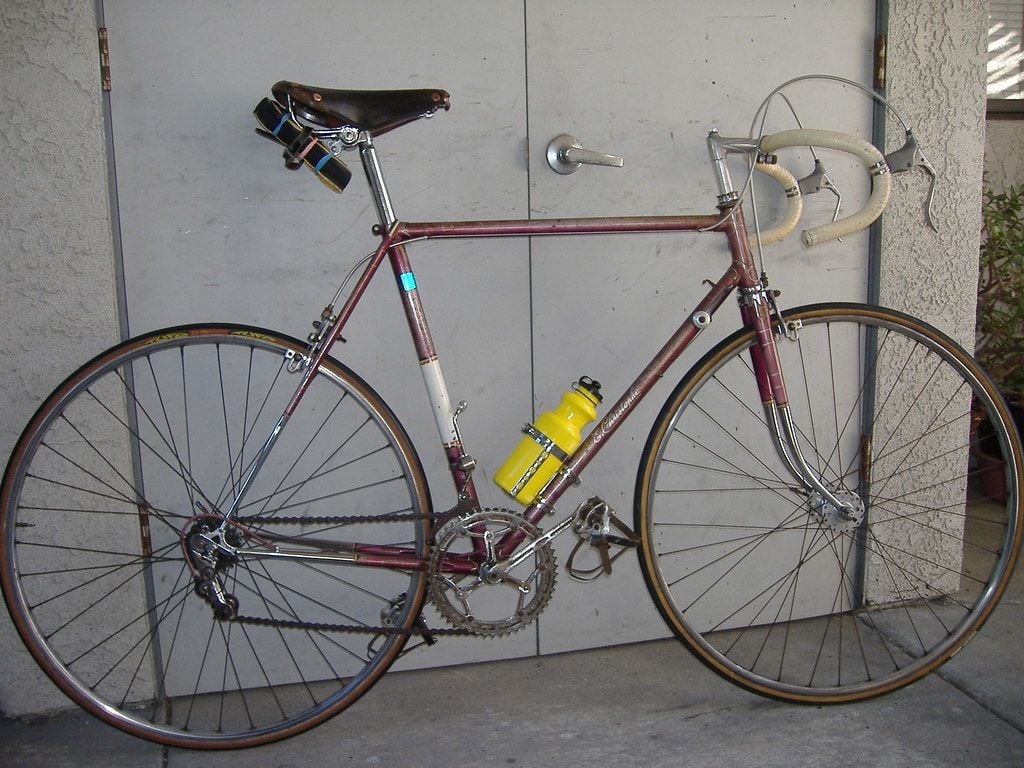
Last edited by dddd; 03-11-24 at 04:00 PM.
#27
Junior Member
Join Date: Dec 2010
Location: Wine Country
Posts: 75
Bikes: 1973 Mercier 300, 1974 Peugeot PX10L, 1975 Lejeune Champion du Monde, 1982 Peugeot PX 10 Super Competition, 1984 Motobecane SP, 1987 Peugeot PX10 "Tout Mavic," 1983 Basso Gap
Mentioned: 0 Post(s)
Tagged: 0 Thread(s)
Quoted: 19 Post(s)
Likes: 0
Liked 9 Times
in
6 Posts
"The longer top tube doesn't improve stability at all, since by itself it takes weight off of the front wheel.
What it does is position the rider closer to the front wheel, for better drafting potential."
Not sure I follow this one point. How can one be positioned closer to the front wheel while at the same time his weight his weight is taken off it? The steep head angle and fork rake would bring the wheel closer while the long TT would place it farther away, unless a steeper seat tube were also used. Optimum weight distribution depends on the situation--cornering, riding downhill, uphill, drafting v breaks/sprints, even time trialing (in those days before the "funny" bikes). The body shifts accordingly. The frame design must balance all these needs.
I do agree that the frame was designed this way intentionally, not a fluke or accident, and that is something I learned from redshift1's post. Dave's points are thought-provoking and much appreciated.
Here is my bike, cleaned up, straightened, reassembled. It's a 1974 PX10L, equivalent to the LE model sold here. 55 (C-T) x 57. Purchased in France. All as original, except for SLJ front derailleur (was a Super Competition, which literally fell apart in my hands), bar (Atax D352; orig was too small and bent), saddle (same Ideal 2002 model but in better shape). Toe clips and straps replaced. Chain is NOS Sedisport I had lying around. Wheels deviate from brochure specs: hubs are Pelissier, very similar to Maillard 700, also made by Perrin. Rims are the expected Monthlery Pros, spokes 15g. I rode it only briefly before I worked on it, so I will better able to comment on its ride once the glue cures and the rain stops.
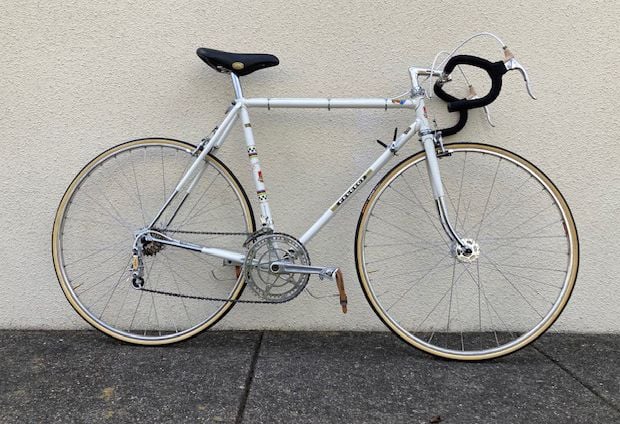
What it does is position the rider closer to the front wheel, for better drafting potential."
Not sure I follow this one point. How can one be positioned closer to the front wheel while at the same time his weight his weight is taken off it? The steep head angle and fork rake would bring the wheel closer while the long TT would place it farther away, unless a steeper seat tube were also used. Optimum weight distribution depends on the situation--cornering, riding downhill, uphill, drafting v breaks/sprints, even time trialing (in those days before the "funny" bikes). The body shifts accordingly. The frame design must balance all these needs.
I do agree that the frame was designed this way intentionally, not a fluke or accident, and that is something I learned from redshift1's post. Dave's points are thought-provoking and much appreciated.
Here is my bike, cleaned up, straightened, reassembled. It's a 1974 PX10L, equivalent to the LE model sold here. 55 (C-T) x 57. Purchased in France. All as original, except for SLJ front derailleur (was a Super Competition, which literally fell apart in my hands), bar (Atax D352; orig was too small and bent), saddle (same Ideal 2002 model but in better shape). Toe clips and straps replaced. Chain is NOS Sedisport I had lying around. Wheels deviate from brochure specs: hubs are Pelissier, very similar to Maillard 700, also made by Perrin. Rims are the expected Monthlery Pros, spokes 15g. I rode it only briefly before I worked on it, so I will better able to comment on its ride once the glue cures and the rain stops.

Last edited by mikestr; 03-12-24 at 02:14 PM.
#28
The Huffmeister
Join Date: Jul 2008
Location: The Le Grande HQ
Posts: 2,741
Bikes: '79 Trek 938, '86 Jim Merz Allez SE, '90 Miyata 1000, '68 PX-10, '80 PXN-10, '73 Super Course, '87 Guerciotti, '83 Trek 600, '80 Huffy Le Grande
Mentioned: 45 Post(s)
Tagged: 0 Thread(s)
Quoted: 1227 Post(s)
Liked 3,560 Times
in
1,412 Posts
Mine (a '68 I believe) is 57cm x 57cm all day long. Sorry about the difficulties of making this one work for you!
__________________
There were 135 Confentes, but only one...Huffente!

There were 135 Confentes, but only one...Huffente!

#29
Junior Member
Join Date: Dec 2010
Location: Wine Country
Posts: 75
Bikes: 1973 Mercier 300, 1974 Peugeot PX10L, 1975 Lejeune Champion du Monde, 1982 Peugeot PX 10 Super Competition, 1984 Motobecane SP, 1987 Peugeot PX10 "Tout Mavic," 1983 Basso Gap
Mentioned: 0 Post(s)
Tagged: 0 Thread(s)
Quoted: 19 Post(s)
Likes: 0
Liked 9 Times
in
6 Posts
#30
Ride, Wrench, Swap, Race
Join Date: Jan 2010
Location: Northern California
Posts: 9,194
Bikes: Cheltenham-Pedersen racer, Boulder F/S Paris-Roubaix, Varsity racer, '52 Christophe, '62 Continental, '92 Merckx, '75 Limongi, '76 Presto, '72 Gitane SC, '71 Schwinn SS, etc.
Mentioned: 132 Post(s)
Tagged: 0 Thread(s)
Quoted: 1565 Post(s)
Liked 1,296 Times
in
866 Posts
Your rear derailer looks a bit too vertical for being in the big ring, but perhaps your chain length is sized for possible later use of a 28t freewheel?
You're right about what I had said about the top tube length and drafting potential, I meant the steeper head tube not the longer top tube (which just happen to go together on these bikes). I clarified/corrected my earlier post.
Although the longer top tube by itself forces the more-forward rider position that is part of the "better drafting" equation. The head tube angle and resultant optimal fork rake are of course just as much a part of said equation.
It will be interesting to hear how your riding impressions jibe with our theoretical understanding of these bike's geometry.
Your chain is long enough to allow moving the rear axle well rearward, to counter the front end's light-steering tendencies.
There's no shame in ditching these bikes plastic front derailer, they are hardly robust enough for real riding at fifty years old.
You're right about what I had said about the top tube length and drafting potential, I meant the steeper head tube not the longer top tube (which just happen to go together on these bikes). I clarified/corrected my earlier post.
Although the longer top tube by itself forces the more-forward rider position that is part of the "better drafting" equation. The head tube angle and resultant optimal fork rake are of course just as much a part of said equation.
It will be interesting to hear how your riding impressions jibe with our theoretical understanding of these bike's geometry.
Your chain is long enough to allow moving the rear axle well rearward, to counter the front end's light-steering tendencies.
There's no shame in ditching these bikes plastic front derailer, they are hardly robust enough for real riding at fifty years old.
#31
Ride, Wrench, Swap, Race
Join Date: Jan 2010
Location: Northern California
Posts: 9,194
Bikes: Cheltenham-Pedersen racer, Boulder F/S Paris-Roubaix, Varsity racer, '52 Christophe, '62 Continental, '92 Merckx, '75 Limongi, '76 Presto, '72 Gitane SC, '71 Schwinn SS, etc.
Mentioned: 132 Post(s)
Tagged: 0 Thread(s)
Quoted: 1565 Post(s)
Liked 1,296 Times
in
866 Posts
Thanks for the higher-res photo. What is the red decal on the top tube near the head tube?
#32
Junior Member
Join Date: Dec 2010
Location: Wine Country
Posts: 75
Bikes: 1973 Mercier 300, 1974 Peugeot PX10L, 1975 Lejeune Champion du Monde, 1982 Peugeot PX 10 Super Competition, 1984 Motobecane SP, 1987 Peugeot PX10 "Tout Mavic," 1983 Basso Gap
Mentioned: 0 Post(s)
Tagged: 0 Thread(s)
Quoted: 19 Post(s)
Likes: 0
Liked 9 Times
in
6 Posts
You're correct: The chain is left slightly long pending a test ride and possible axle adjustment. I find it easier to remove links than install them. Several links had already been removed. No, I won't be installing a 28t FW.
The red sticker was applied by the original French dealer, and I left it as part of the bike's history.
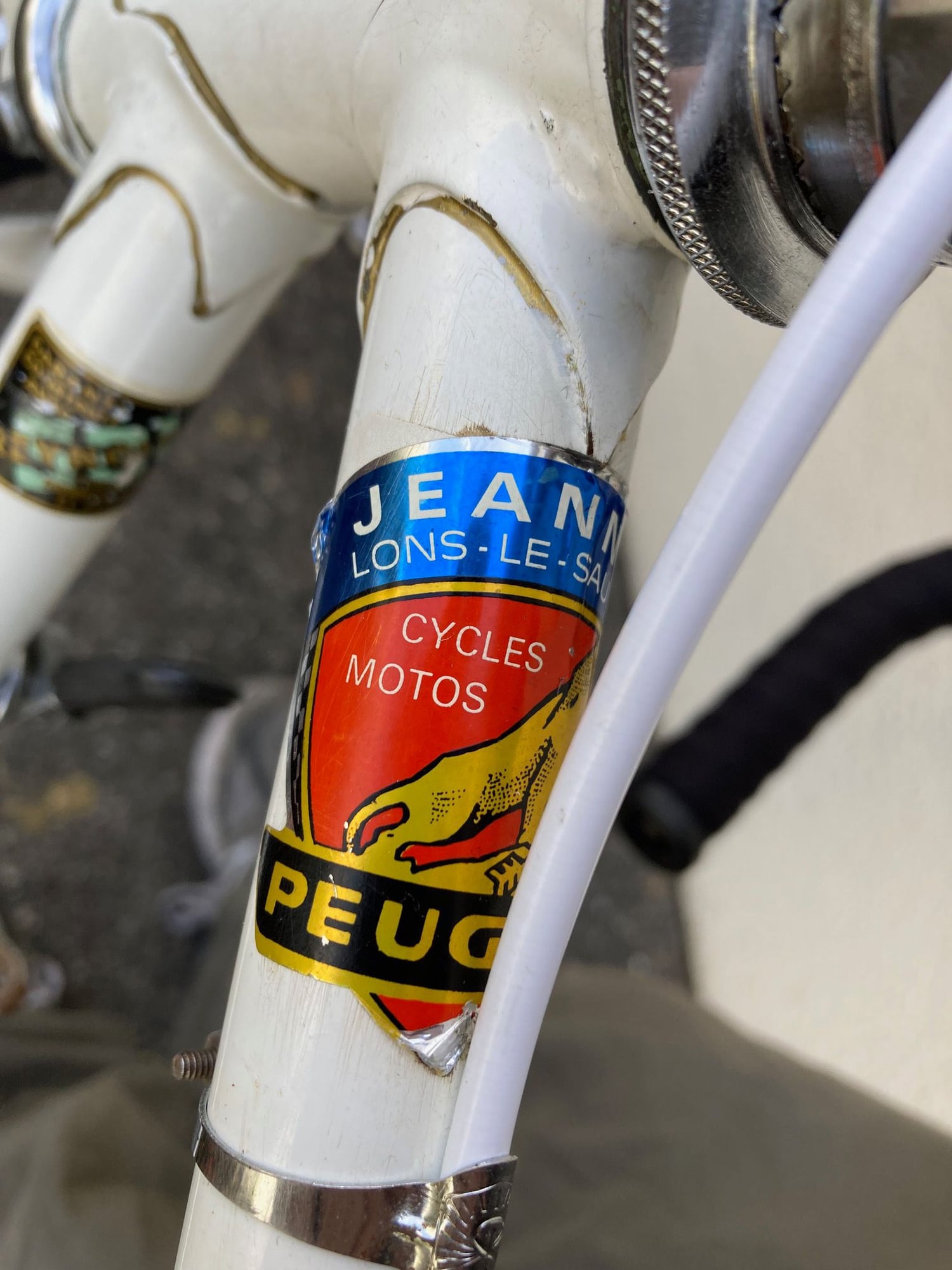
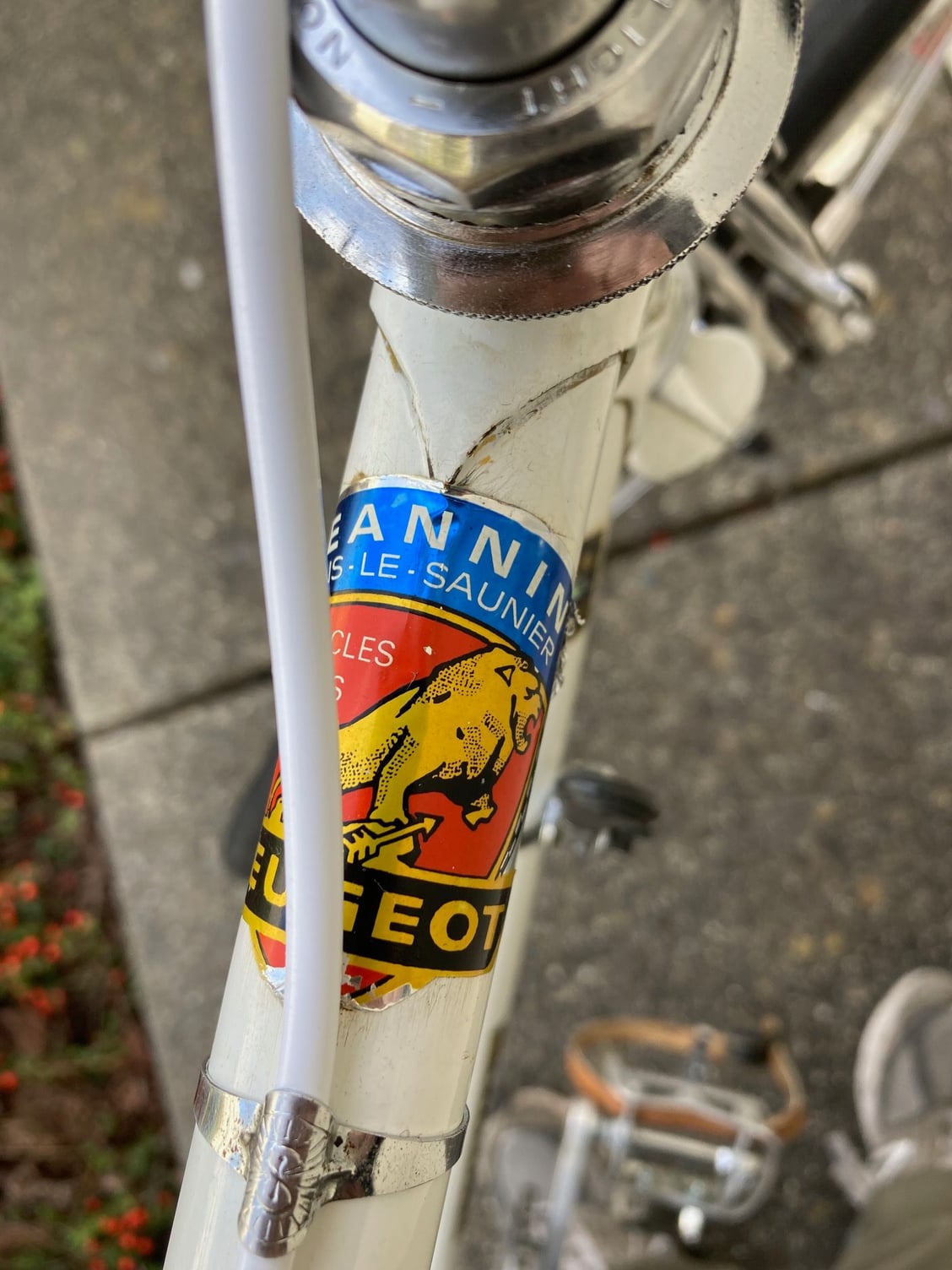
That particular plastic derailleur was poor engineering, as the use of the pivot as a cable stop reduced its thickness to the point of fragility. Mine fell apart when I removed it from the seat tube. I found it interesting that this same combination of derailleurs appears on the bikes shown in the official 1974 Peugeot team photo. Perhaps the SLJ front derailleur was not yet available and the Super Competition model was all they had?
The red sticker was applied by the original French dealer, and I left it as part of the bike's history.


That particular plastic derailleur was poor engineering, as the use of the pivot as a cable stop reduced its thickness to the point of fragility. Mine fell apart when I removed it from the seat tube. I found it interesting that this same combination of derailleurs appears on the bikes shown in the official 1974 Peugeot team photo. Perhaps the SLJ front derailleur was not yet available and the Super Competition model was all they had?
Likes For mikestr:
#33
Junior Member
Join Date: Dec 2010
Location: Wine Country
Posts: 75
Bikes: 1973 Mercier 300, 1974 Peugeot PX10L, 1975 Lejeune Champion du Monde, 1982 Peugeot PX 10 Super Competition, 1984 Motobecane SP, 1987 Peugeot PX10 "Tout Mavic," 1983 Basso Gap
Mentioned: 0 Post(s)
Tagged: 0 Thread(s)
Quoted: 19 Post(s)
Likes: 0
Liked 9 Times
in
6 Posts
Finally jumped on the bike and had a very brief ride just to check my work. Dave's description feels right: It's a real race bike, and the most natural position is forward and low over the bars, where lots of power can be generated. It's very responsive but it doesn't feel unstable. For me the fit is good and the handling nimble but predictable.
I highly recommend that any bike's alignment be checked and corrected if needed. Peugeots were built straight in my experience, but past accidents are to be assumed, and even a slightly twisted frame can really influence the ride. Thanks to Ed Litton for his work.
I highly recommend that any bike's alignment be checked and corrected if needed. Peugeots were built straight in my experience, but past accidents are to be assumed, and even a slightly twisted frame can really influence the ride. Thanks to Ed Litton for his work.
Likes For mikestr:
#34
Full Member
Join Date: Jul 2023
Location: Idaho, USA
Posts: 218
Bikes: Aluminum and Steel
Mentioned: 1 Post(s)
Tagged: 0 Thread(s)
Quoted: 103 Post(s)
Liked 377 Times
in
139 Posts
Great advice. I will check my new to me PX10 thouroughly once it’s stripped down. I failed to check an A08 recently and it pulled to the right post rehab on its test ride. It never crossed my mind to check for straightness. I’m a rookie for one and two the paint/decals looked great.
__________________
“Ride like the wind boy! Ride like the wind…”
-The Voice inside my head, circa 1982
“Ride like the wind boy! Ride like the wind…”
-The Voice inside my head, circa 1982
#35
The Huffmeister
Join Date: Jul 2008
Location: The Le Grande HQ
Posts: 2,741
Bikes: '79 Trek 938, '86 Jim Merz Allez SE, '90 Miyata 1000, '68 PX-10, '80 PXN-10, '73 Super Course, '87 Guerciotti, '83 Trek 600, '80 Huffy Le Grande
Mentioned: 45 Post(s)
Tagged: 0 Thread(s)
Quoted: 1227 Post(s)
Liked 3,560 Times
in
1,412 Posts
#36
Junior Member
Join Date: Dec 2010
Location: Wine Country
Posts: 75
Bikes: 1973 Mercier 300, 1974 Peugeot PX10L, 1975 Lejeune Champion du Monde, 1982 Peugeot PX 10 Super Competition, 1984 Motobecane SP, 1987 Peugeot PX10 "Tout Mavic," 1983 Basso Gap
Mentioned: 0 Post(s)
Tagged: 0 Thread(s)
Quoted: 19 Post(s)
Likes: 0
Liked 9 Times
in
6 Posts
#37
Junior Member
Join Date: Dec 2010
Location: Wine Country
Posts: 75
Bikes: 1973 Mercier 300, 1974 Peugeot PX10L, 1975 Lejeune Champion du Monde, 1982 Peugeot PX 10 Super Competition, 1984 Motobecane SP, 1987 Peugeot PX10 "Tout Mavic," 1983 Basso Gap
Mentioned: 0 Post(s)
Tagged: 0 Thread(s)
Quoted: 19 Post(s)
Likes: 0
Liked 9 Times
in
6 Posts
Perhaps redshft1's (OP's) complaint has a more general cause that got lost (partly thanks to me) in the discussion of this particular model. If a 54x54 frame doesn't work for him even with. 6 cm stem, it's likely that one or more of the following are true or partially true:
He is trying to ride too large a frame;
He has an unusually short torso and reach;
He's attempting to achieve a more upright riding position than the typical racing frame is designed for.
As for the last cause, I myself struggle a bit with the conflicting requirements of riding efficiently and fast with needing to watch for traffic, or even enjoying the scenery without straining. But raising the stem (and/or choosing a shorter one) to sit more upright also removes me from the "sweet spot," the somewhat narrow range of positions for which a frame like the present one was designed, and I lose most of the sense of it. It would be a bit like replacing the suspension on a sports car to make it ride like a limousine. Sometimes it's better to choose a different type of vehicle?
He is trying to ride too large a frame;
He has an unusually short torso and reach;
He's attempting to achieve a more upright riding position than the typical racing frame is designed for.
As for the last cause, I myself struggle a bit with the conflicting requirements of riding efficiently and fast with needing to watch for traffic, or even enjoying the scenery without straining. But raising the stem (and/or choosing a shorter one) to sit more upright also removes me from the "sweet spot," the somewhat narrow range of positions for which a frame like the present one was designed, and I lose most of the sense of it. It would be a bit like replacing the suspension on a sports car to make it ride like a limousine. Sometimes it's better to choose a different type of vehicle?
#38
The Huffmeister
Join Date: Jul 2008
Location: The Le Grande HQ
Posts: 2,741
Bikes: '79 Trek 938, '86 Jim Merz Allez SE, '90 Miyata 1000, '68 PX-10, '80 PXN-10, '73 Super Course, '87 Guerciotti, '83 Trek 600, '80 Huffy Le Grande
Mentioned: 45 Post(s)
Tagged: 0 Thread(s)
Quoted: 1227 Post(s)
Liked 3,560 Times
in
1,412 Posts
#39
Senior Member
Join Date: Jun 2006
Posts: 20,305
Mentioned: 130 Post(s)
Tagged: 0 Thread(s)
Quoted: 3464 Post(s)
Liked 2,831 Times
in
1,997 Posts
"The longer top tube doesn't improve stability at all, since by itself it takes weight off of the front wheel.
What it does is position the rider closer to the front wheel, for better drafting potential."
Not sure I follow this one point. How can one be positioned closer to the front wheel while at the same time his weight his weight is taken off it? The steep head angle and fork rake would bring the wheel closer while the long TT would place it farther away, unless a steeper seat tube were also used. Optimum weight distribution depends on the situation--cornering, riding downhill, uphill, drafting v breaks/sprints, even time trialing (in those days before the "funny" bikes). The body shifts accordingly. The frame design must balance all these needs.
I do agree that the frame was designed this way intentionally, not a fluke or accident, and that is something I learned from redshift1's post. Dave's points are thought-provoking and much appreciated.
Here is my bike, cleaned up, straightened…

What it does is position the rider closer to the front wheel, for better drafting potential."
Not sure I follow this one point. How can one be positioned closer to the front wheel while at the same time his weight his weight is taken off it? The steep head angle and fork rake would bring the wheel closer while the long TT would place it farther away, unless a steeper seat tube were also used. Optimum weight distribution depends on the situation--cornering, riding downhill, uphill, drafting v breaks/sprints, even time trialing (in those days before the "funny" bikes). The body shifts accordingly. The frame design must balance all these needs.
I do agree that the frame was designed this way intentionally, not a fluke or accident, and that is something I learned from redshift1's post. Dave's points are thought-provoking and much appreciated.
Here is my bike, cleaned up, straightened…

For whatever reason I have seen PX’s that took a punch to the front and the best description is the head tube moved up in relation to the seat tube. Resulting in a steeper head angle. One bike was close to unrideable.
you stated the frame was straightened, in what manner?
I think this one could use a framebuilder’s review, on the surface table and referencing the frame angles and bottom bracket drop.
When a head tube gets pushed up, it lowers the BB and makes the Head tube and seat tube steeper.
#40
Friendship is Magic
Join Date: Nov 2010
Location: Sacramento, CA
Posts: 22,985
Bikes: old ones
Mentioned: 304 Post(s)
Tagged: 0 Thread(s)
Quoted: 26425 Post(s)
Liked 10,381 Times
in
7,209 Posts
..yes, as you have determined there was a certain period where these were made and sold like this. I have one that I built up with 27" clincher wheels, because they sold a model like that ,(in one of the catalogs you can find a picture of it.) They are "quick" in handling, but not unmanageable. Mine was not bentwhen I got it, and has never been straightened. Its not bent now, it's just a cycle with a very steep head tube.
I'm an experienced rider, but it's not like I have superpowers. If I can ride it, I presume anyone can. You do have to be mindful of your toe overlap, but once you hit a certain minimum speed, turning is more about weight change than turning the front wheel very far. So basically not an issue. Here's a picture.
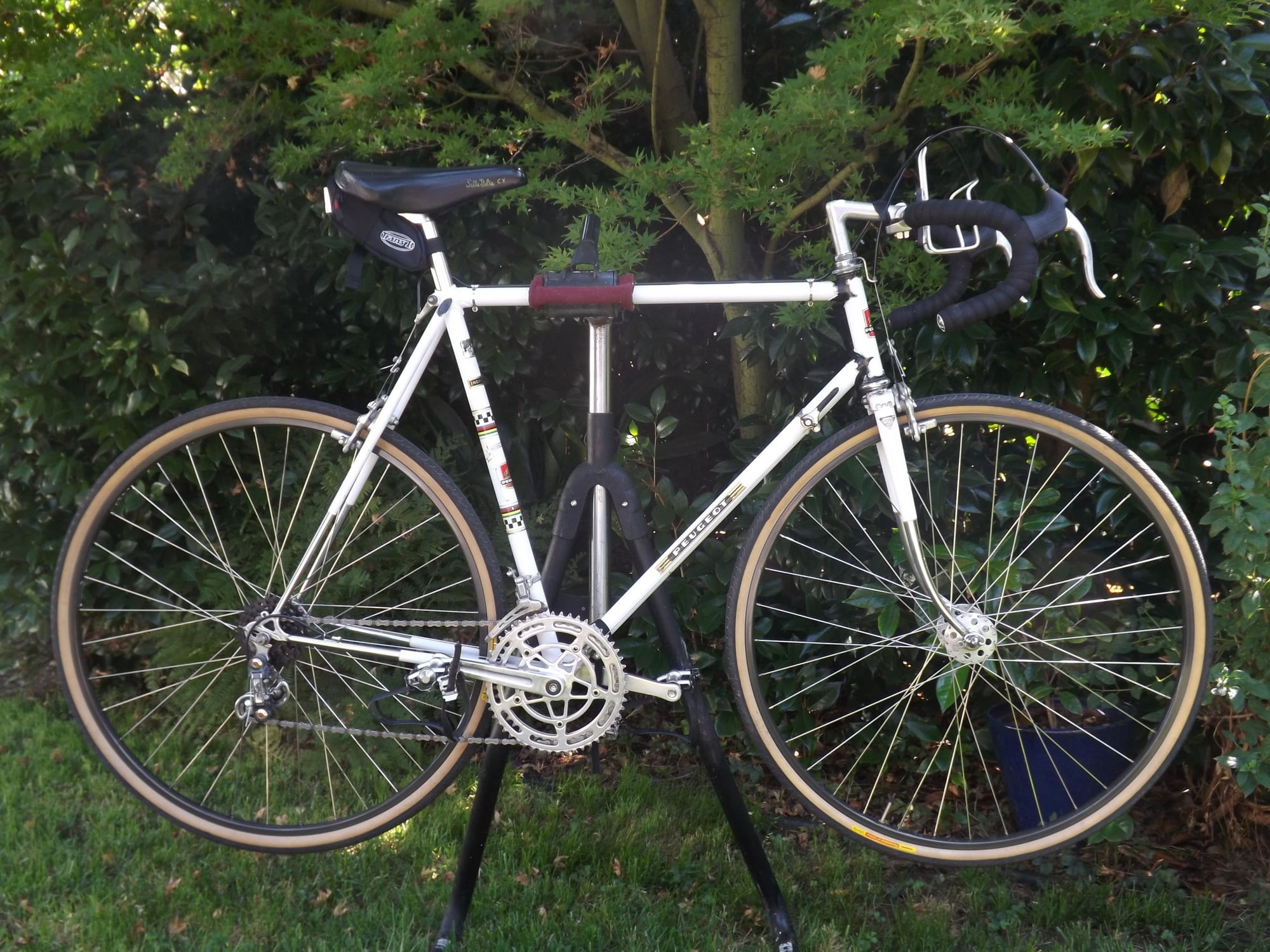
This one came into the US with a guy who bought it at a pro shop in Germany. He rode it into the ground, but I wanted a PX-10 with Nervar lugs, so I bought it as a project, bought another donor bike, and reconstructed this one using the donor components. I would not have done that, if I thought the frame was bent...and I have the usual stuff to check frame and fork alignment...no frame table.
__________________
#41
Junior Member
Join Date: Dec 2010
Location: Wine Country
Posts: 75
Bikes: 1973 Mercier 300, 1974 Peugeot PX10L, 1975 Lejeune Champion du Monde, 1982 Peugeot PX 10 Super Competition, 1984 Motobecane SP, 1987 Peugeot PX10 "Tout Mavic," 1983 Basso Gap
Mentioned: 0 Post(s)
Tagged: 0 Thread(s)
Quoted: 19 Post(s)
Likes: 0
Liked 9 Times
in
6 Posts
Nice result you got. Is there a pattern here--three of us in Northern California? My frame actually was a bit bent but after straightening still had a very steep head tube angle, like the others shown here. Fortunately the bend was very slight; had there been a bulge, crease, or cracked paint I would have discarded the frame.
I meant to ask you guys: What rear spacing did your frames come with? Did they by any chance have 126mm but a 5-speed FW? Mine did.
I meant to ask you guys: What rear spacing did your frames come with? Did they by any chance have 126mm but a 5-speed FW? Mine did.
#42
Junior Member
Join Date: Dec 2010
Location: Wine Country
Posts: 75
Bikes: 1973 Mercier 300, 1974 Peugeot PX10L, 1975 Lejeune Champion du Monde, 1982 Peugeot PX 10 Super Competition, 1984 Motobecane SP, 1987 Peugeot PX10 "Tout Mavic," 1983 Basso Gap
Mentioned: 0 Post(s)
Tagged: 0 Thread(s)
Quoted: 19 Post(s)
Likes: 0
Liked 9 Times
in
6 Posts
from the other images, I would remove that top tube foil sticker. Hair dryer and/or heat gun to preserve the graphic. Shows a transverse paint fracture. The sticker is not original, increasing my suspicion.
Not a paint fracture. Simply the edge of the clear film of the transfer. The other fine lines are scratches. The sticker is original, applied by the dealer. There is no "grap[hic" it is concealing. You are free to remove yours if you have one.
"For whatever reason I have seen PX’s that took a punch to the front and the best description is the head tube moved up in relation to the seat tube. Resulting in a steeper head angle. One bike was close to unrideable."
With mine it was barely detectable. I had to place a straightedge to the TT to see it--little sliver of daylight. Estimated to be of the order of 1.5 - 2 degrees extra in the head tube angle. Forks not bent but blades very slightly pushed to one side. I knew there had been some mishap because the brake hanger was bent to one side. Otherwise it was hard to tell.
"you stated the frame was straightened, in what manner?"
In the manner and workshop of a frame builder, in this case Ed Litton. He had an alignment table and all the proper tools. He also cleaned up the BB threads and fixed the out-of-round condition of the seat tube caused by someone overtightening the binder bolt (which bent the bolt and distorted the steel seat pillar. The frame is perfectly straight, dropouts parallel, all bearing seats machined.
"I think this one could use a framebuilder’s review, on the surface table and referencing the frame angles and bottom bracket drop.
When a head tube gets pushed up, it lowers the BB and makes the Head tube and seat tube steeper.
Not a paint fracture. Simply the edge of the clear film of the transfer. The other fine lines are scratches. The sticker is original, applied by the dealer. There is no "grap[hic" it is concealing. You are free to remove yours if you have one.
"For whatever reason I have seen PX’s that took a punch to the front and the best description is the head tube moved up in relation to the seat tube. Resulting in a steeper head angle. One bike was close to unrideable."
With mine it was barely detectable. I had to place a straightedge to the TT to see it--little sliver of daylight. Estimated to be of the order of 1.5 - 2 degrees extra in the head tube angle. Forks not bent but blades very slightly pushed to one side. I knew there had been some mishap because the brake hanger was bent to one side. Otherwise it was hard to tell.
"you stated the frame was straightened, in what manner?"
In the manner and workshop of a frame builder, in this case Ed Litton. He had an alignment table and all the proper tools. He also cleaned up the BB threads and fixed the out-of-round condition of the seat tube caused by someone overtightening the binder bolt (which bent the bolt and distorted the steel seat pillar. The frame is perfectly straight, dropouts parallel, all bearing seats machined.
"I think this one could use a framebuilder’s review, on the surface table and referencing the frame angles and bottom bracket drop.
When a head tube gets pushed up, it lowers the BB and makes the Head tube and seat tube steeper.
#43
Junior Member
Join Date: Dec 2010
Location: Wine Country
Posts: 75
Bikes: 1973 Mercier 300, 1974 Peugeot PX10L, 1975 Lejeune Champion du Monde, 1982 Peugeot PX 10 Super Competition, 1984 Motobecane SP, 1987 Peugeot PX10 "Tout Mavic," 1983 Basso Gap
Mentioned: 0 Post(s)
Tagged: 0 Thread(s)
Quoted: 19 Post(s)
Likes: 0
Liked 9 Times
in
6 Posts
Looks like all but the last of my responses got combined with the quote of Repechage. Sorry, I'm not adept with this medium.
#44
Junior Member
Join Date: Dec 2010
Location: Wine Country
Posts: 75
Bikes: 1973 Mercier 300, 1974 Peugeot PX10L, 1975 Lejeune Champion du Monde, 1982 Peugeot PX 10 Super Competition, 1984 Motobecane SP, 1987 Peugeot PX10 "Tout Mavic," 1983 Basso Gap
Mentioned: 0 Post(s)
Tagged: 0 Thread(s)
Quoted: 19 Post(s)
Likes: 0
Liked 9 Times
in
6 Posts
"The sticker is not original, increasing my suspicion."
There is zero evidence of anyone concealing a fault in the frame. There was plenty of evidence of general neglect and nonuse of the bike for decades. It had all original cabling, ancient tires, was completely uncleaned and filthy. The fault in the frame was so slight that it would not have been noticed let alone concealed. This was an entirely complete, original PX10L that someone simply lost interest in and put in their basement. Nothing at all was done to pretty it up for sale. The frame was thoroughly inspected for cracks or other serious damage at the frame builder's shop. There is none.
And I guess I have to ask what "original" means. Only that which was added at the factory? What about the dealer? If he paints the customer's name on the top tube or changes out a stem is that not original? Dealers slapped their stickers on new bikes almost routinely; it even happened here. In France it was practically ubiquitous and often garish, usually on the seat tube, but commonly elsewhere. Removing such stickers or not is a personal decision. If one wants his bike to look exactly like the brochure photo, without any sense of individual history, he will remove these. That's also a valid choice.
There is zero evidence of anyone concealing a fault in the frame. There was plenty of evidence of general neglect and nonuse of the bike for decades. It had all original cabling, ancient tires, was completely uncleaned and filthy. The fault in the frame was so slight that it would not have been noticed let alone concealed. This was an entirely complete, original PX10L that someone simply lost interest in and put in their basement. Nothing at all was done to pretty it up for sale. The frame was thoroughly inspected for cracks or other serious damage at the frame builder's shop. There is none.
And I guess I have to ask what "original" means. Only that which was added at the factory? What about the dealer? If he paints the customer's name on the top tube or changes out a stem is that not original? Dealers slapped their stickers on new bikes almost routinely; it even happened here. In France it was practically ubiquitous and often garish, usually on the seat tube, but commonly elsewhere. Removing such stickers or not is a personal decision. If one wants his bike to look exactly like the brochure photo, without any sense of individual history, he will remove these. That's also a valid choice.
#45
Senior Member
Join Date: Jun 2006
Posts: 20,305
Mentioned: 130 Post(s)
Tagged: 0 Thread(s)
Quoted: 3464 Post(s)
Liked 2,831 Times
in
1,997 Posts
What caught my eye-
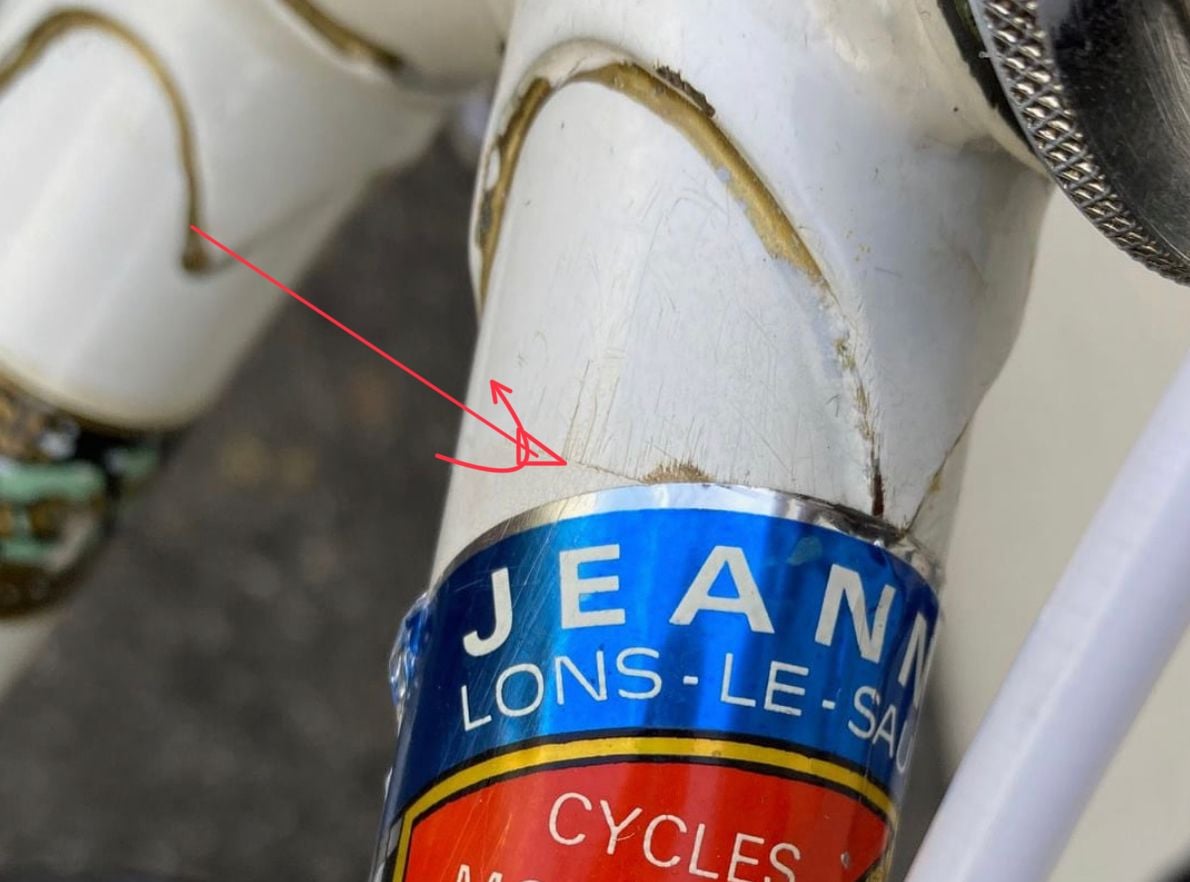

Likes For repechage:
#46
Friendship is Magic
Join Date: Nov 2010
Location: Sacramento, CA
Posts: 22,985
Bikes: old ones
Mentioned: 304 Post(s)
Tagged: 0 Thread(s)
Quoted: 26425 Post(s)
Liked 10,381 Times
in
7,209 Posts
Nice result you got. Is there a pattern here--three of us in Northern California? My frame actually was a bit bent but after straightening still had a very steep head tube angle, like the others shown here. Fortunately the bend was very slight; had there been a bulge, crease, or cracked paint I would have discarded the frame.
I meant to ask you guys: What rear spacing did your frames come with? Did they by any chance have 126mm but a 5-speed FW? Mine did.
I meant to ask you guys: What rear spacing did your frames come with? Did they by any chance have 126mm but a 5-speed FW? Mine did.
 Nothing will convince him otherwise, not even the '74 catalog picture. I don't recall the spacing on mine. I readjust them as part of my process, and I don't usually remember stuff like that. Mine had been rode hard and put away wet, so I wouldn't have assumed whatever it was as original anyway.
Nothing will convince him otherwise, not even the '74 catalog picture. I don't recall the spacing on mine. I readjust them as part of my process, and I don't usually remember stuff like that. Mine had been rode hard and put away wet, so I wouldn't have assumed whatever it was as original anyway.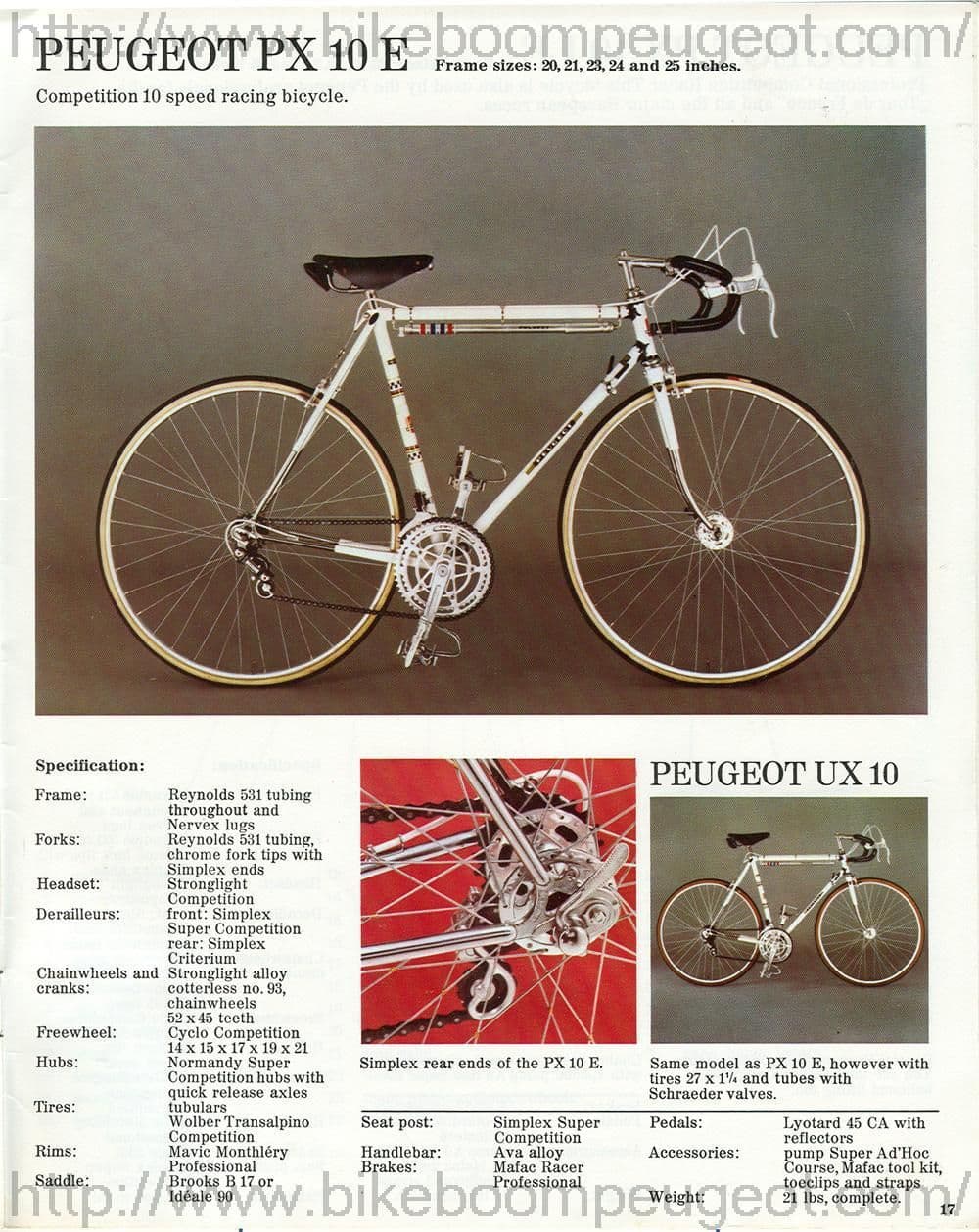
__________________
#47
Junior Member
Join Date: Dec 2010
Location: Wine Country
Posts: 75
Bikes: 1973 Mercier 300, 1974 Peugeot PX10L, 1975 Lejeune Champion du Monde, 1982 Peugeot PX 10 Super Competition, 1984 Motobecane SP, 1987 Peugeot PX10 "Tout Mavic," 1983 Basso Gap
Mentioned: 0 Post(s)
Tagged: 0 Thread(s)
Quoted: 19 Post(s)
Likes: 0
Liked 9 Times
in
6 Posts
And mine matched the photo of the PX10LE in the same brochure. I think it's now pretty well established that Peugeot was building the PX10/UX10 with steep head tube angles and reduced fork rake between around 1972 and 1974. You can actually measure the angles in the photos themselves. The change in rake is obvious.
On the Bike Boom Peugeot site there are Japanese brochures as well. These are especially interesting: The 1974 "Super PX10E" is fitted with the SLJ alloy derailleurs and 6 speed freewheels. Angles also steep.
On the Bike Boom Peugeot site there are Japanese brochures as well. These are especially interesting: The 1974 "Super PX10E" is fitted with the SLJ alloy derailleurs and 6 speed freewheels. Angles also steep.
#48
Senior Member
Join Date: Jun 2006
Posts: 20,305
Mentioned: 130 Post(s)
Tagged: 0 Thread(s)
Quoted: 3464 Post(s)
Liked 2,831 Times
in
1,997 Posts
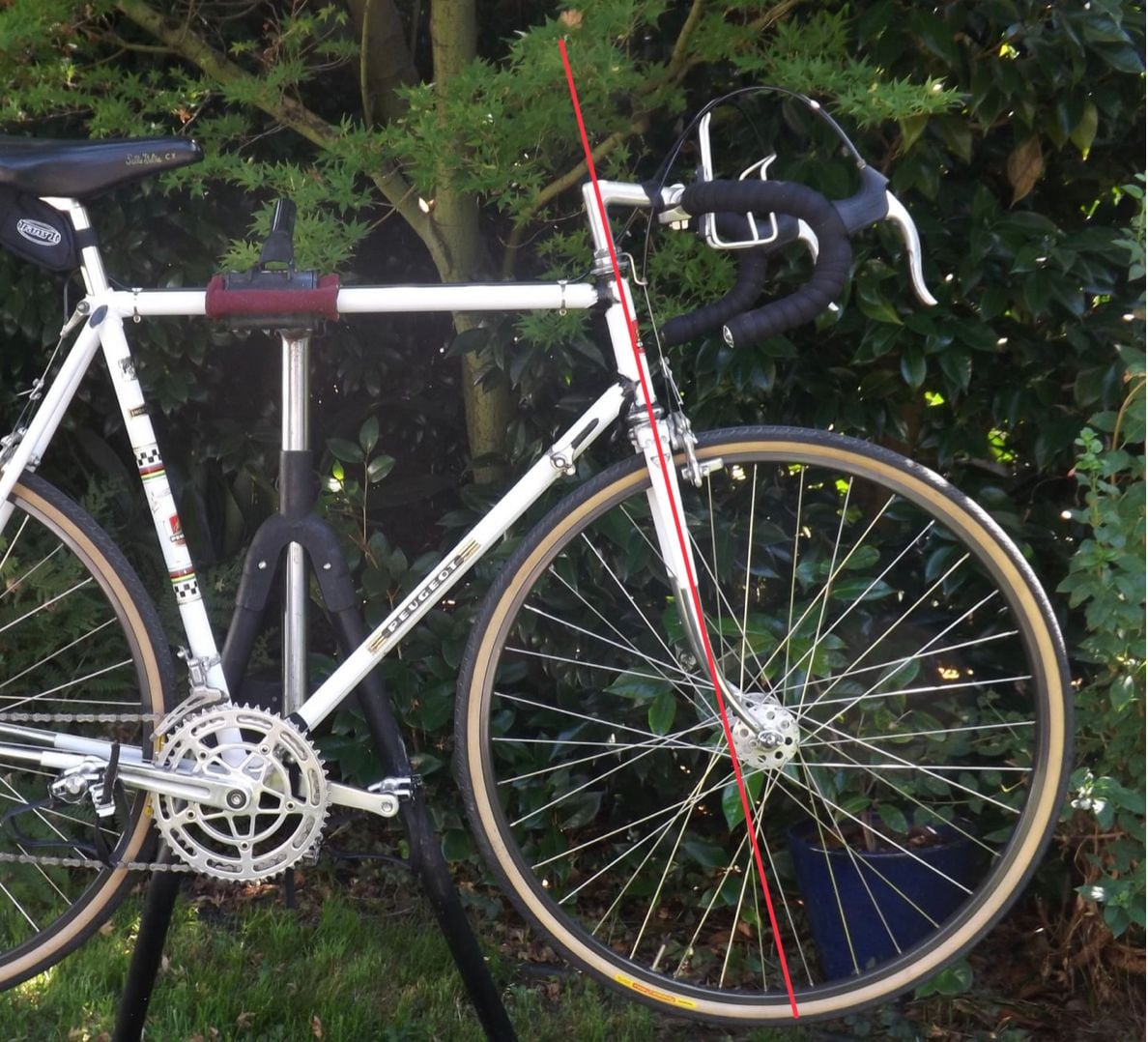
‘this is not parallax.
note the fork legs do not bisect the steering axis.
#49
Friendship is Magic
Join Date: Nov 2010
Location: Sacramento, CA
Posts: 22,985
Bikes: old ones
Mentioned: 304 Post(s)
Tagged: 0 Thread(s)
Quoted: 26425 Post(s)
Liked 10,381 Times
in
7,209 Posts
...we've been over this before. If you think you can diagnose something like this from a photograph, I'm happy for you. I cannot. If that's a personal failing on my part, then I am imperfect.
__________________
Likes For 3alarmer:
#50
Junior Member
Join Date: Dec 2010
Location: Wine Country
Posts: 75
Bikes: 1973 Mercier 300, 1974 Peugeot PX10L, 1975 Lejeune Champion du Monde, 1982 Peugeot PX 10 Super Competition, 1984 Motobecane SP, 1987 Peugeot PX10 "Tout Mavic," 1983 Basso Gap
Mentioned: 0 Post(s)
Tagged: 0 Thread(s)
Quoted: 19 Post(s)
Likes: 0
Liked 9 Times
in
6 Posts
When I said that it is possible to measure frame angles in a photograph I did not mean to suggest that it is necessarily easy. The photo must be taken from a suitable distance straight on, and must not have any rectilinear distortion. Fork blade angles are very tricky, the fork is almost always rotated at least slightly, as in the above image. I think one should be modest in one's expectations of precision. I would say that if the view is straight on, the wheels will appear perfectly round (rarely happens except in a careful studio setup with a view camera and commercial lenses). In that case one can measure frame angles to within a degree, and gross differences in geometry can certainly be detected and approximately quantified. I cannot tell in the above picture if the fork is bent.
Let's try to resist the temptation to pick out faults in others' bikes--it serves no purpose but to annoy. Sometimes such advice is couched in terms made to suggest that help is being offered, but it's nitpicking and devaluing just the same.
As for this strange period of PX10 production, there is little doubt that a much more aggressive geometry was used. It's seen in bikes from that period; it's seen in the brochures. It's not that subtle. I myself own PX10s from 1974, 1982, and 1987. The '74 is clearly the outlier in this regard.
Let's try to resist the temptation to pick out faults in others' bikes--it serves no purpose but to annoy. Sometimes such advice is couched in terms made to suggest that help is being offered, but it's nitpicking and devaluing just the same.
As for this strange period of PX10 production, there is little doubt that a much more aggressive geometry was used. It's seen in bikes from that period; it's seen in the brochures. It's not that subtle. I myself own PX10s from 1974, 1982, and 1987. The '74 is clearly the outlier in this regard.










